KALI
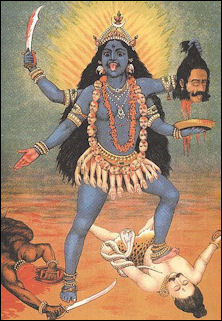
Kali Kali — the Goddess of Death — is a form of Shakti, a wife of Shiva and the daughter of a fierce mountain god. Also known as Durga, she is often pictured with three eyes, black skin, a tongue dripping blood, a necklace of skulls and a sword used for cutting off heads, and is sometimes shown with a severed head in one hand and a cobra wrapped around her neck. Kali is known for her dance of death and is revered for coming to earth and defeating the hideous demon Raktavijra, known for being ability to reproduce himself 1,000 times with each drop of his blood that falls to earth.
Like Shiva, Kali is regarded as both a destroyer and a creator of life, but is feared because she has taken her demon slaying too far, demanding blood sacrifices from humans and once almost killing Shiva. Kali is the patron saint of thieves and a creator of problems for travelers as well a goddess that delivers good things to those that worship her. She was born as a fully grown woman with ten arms and acquired her taste for blood when she killed Raktavijra and drank his blood to prevent him from reaching the earth so he could reproduce himself.
Kali is often depicted as a warrior with weapons in each hand. She rides a tiger or lion, fights with a buffalo and frequently is shown sitting on a lotus platform, holding a lotus flower, beads, a water pot and sometimes the trident of Shiva. Many of here followers feel her hostile reputation is undeserved because most her aggression is focused on defeating and slaying demons. Kali is arguable the most popular of all Hindu goddesses and is especially popular in Calcutta and Bengal in eastern India, where she is known as Durga. Explaining why Kali is so popular despite here bloodthirsty nature, a taxi driver in Calcutta, told the New York Times, "Outside, she is looking very bad. But inside, Kali is very sweet goddess. Whatever you want — house, job, car, husband, child — when you make her sacrifice, then she will give it anything."
Websites and Resources on Hinduism: Hinduism Today hinduismtoday.com ; India Divine indiadivine.org ; Wikipedia article Wikipedia ; Oxford center of Hindu Studies ochs.org.uk ; Hindu Website hinduwebsite.com/hinduindex ; Hindu Gallery hindugallery.com ; Encyclopædia Britannica Online article britannica.com ; International Encyclopedia of Philosophy iep.utm.edu/hindu ; The Hindu Religion, Swami Vivekananda (1894), .wikisource.org ; Journal of Hindu Studies, Oxford University Press academic.oup.com/jhs
RECOMMENDED BOOKS:
“Hindu Myths: A Sourcebook” translated from the Sanskrit by Wendy Doniger (Penguin Classics, 2004) Amazon.com ;
“Indian Mythology” by Veronica Ions (Peter Bedrick 1984) Amazon.com ;
“Hindu Gods and Goddesses” by Swami Harshananda (Author), M.T.V. Acharya (Illustrator) Amazon.com ;
“Hindu Goddesses: Visions of the Divine Feminine in the Hindu Religious Tradition” (Studies in the History of Religions) by David Kinsley Amazon.com ;
“Myths and Symbols in Indian Art and Civilization” by Heinrich Zimmer (Princeton University Press, 1992) Amazon.com ;
"An Introduction to Hinduism" by Gavin Flood Amazon.com ;
"The Hindus: An Alternative History" by Wendy Doniger; Amazon.com ;
“The Mahabharata” by John D. Smith and Anonymous (Penguin Classics) Amazon.com ;
“The Bhagavad Gita” by Anonymous and Laurie L. Patton (Penguin Classics)
Amazon.com ;
“The Ramayana: A Shortened Modern Prose Version of the Indian Epic” by by R. K. Narayan and Pankaj Mishra (Penguin Classics) Amazon.com ;
“The Illustrated Ramayana: The Timeless Epic of Duty, Love, and Redemption”
by DK and Bibek Debroy Amazon.com
Kali Worship and Rituals
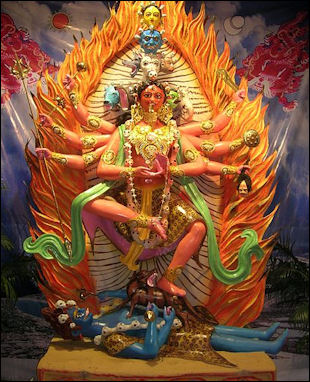
Gujhyakali Hindus have honored Kali with small clay idols called “purjas” , a major festival in Calcutta, and a film shown over and over again that features her as a lion and a goddess that shoots lightning bolts from the third eye on her forehead that are capable of decapitating demons and producing a lot of blood.
The rituals and objects that honor Kali are often quite gruesome or macabre. Purjas sold at festivals show her strangling pregnant women. Cremation grounds, normally regarded as places of pollution, are regarded by some Kali followers as places of rebirth, worship and meditation. Some devotion rituals — such as chanting Kali’s 108 names in Sanskrit and laying a garland of limes at the feet of her images’are more mundane.
Kali is sometimes honored and placated with animal sacrifices. In most cases a goat is sacrificed to say thanks for some particularly good fortune. The animal is decapitated with a quick chop. It is considered auspicious to be splattered with the blood. The head is given to the Brahma priest who performs the sacrifice. The person who offered the goat for sacrifice gets to take the carcass home and eat it.
Humans at one time were sacrificed for Kali. The practice is still believed to be kept alive in some parts of Bihar, where there is some evidence that rituals involving child sacrifices have been conducted by followers of cults that worship goddess Kali. See Tantric Rituals Below.
See Tantrism and Thugs
Kali, Parvati and Durga
Parvati, in a variety of forms, is the most common focus of devotion in India. The wife of Shiva, she presents two main facets to her worshipers: a benign and accepting personality that provides assistance and a powerful and dangerous personality that must be placated. The benign vision exists in many temples to Shiva throughout the country, where the goddess has her own shrine that is in practice the most frequented site of heartfelt devotion. During annual festivals in which the god and goddess emerge from their shrines and travel in processions, it is often the goddess who is most eagerly anticipated. In North India, for example, life-like statues of the loving goddess Kali, who is ultimately a manifestation of Parvati, are carried through huge crowds that line village and city streets. In South India, where gigantic temples are the physical and social centers of town life, the shrines and their annual festivals are often known by the names of their goddesses. One of the more famous is the sixteenth- and seventeenth-century Minakshi Temple in Madurai, Tamil Nadu. The temple is named after the "fish-eyed goddess" Minakshi, described in myths as a dark queen born with three breasts, who set out to conquer the universe. After overrunning the world and vanquishing the gods, Minakshi finally met Shiva and, when her third breast disappeared, accepted him as her lord. This motif of physical power and energy appears in many stories where the goddess is a warrior or conqueror of demons who in the end joins with Shiva. *
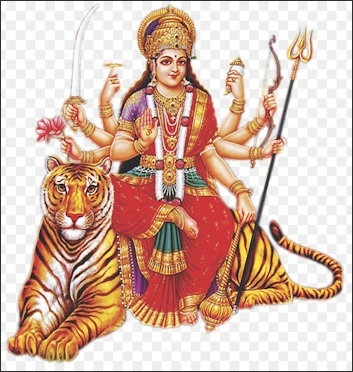
Durga
Alternative visions, however, portray a goddess on the loose, with the potential for causing havoc in the world unless appeased. The goddess Durga is a great warrior who carries swords and a shield, rides a tiger, and destroys demons when the gods prove incapable; in this incarnation, she never submits, but remains capable of terrible deeds of war. The goddess Kali often appears as an even more horrific vision of the divine, with garlands of human skulls around her neck and a severed head in her hand; her bloody tongue hangs from her mouth, and the weapons in her arms drip gore. This image attempts to capture the destructive capacity of the divine, the suffering in the world, and the ultimate return of all things to the goddess at death. *
In many small shrines throughout India, in marked contrast to the large and ornate temples dominated by Brahmanical principles and the philosophy of nonviolence, the female divinity receives regular gifts of blood sacrifices, usually chickens and goats. In addition, the goddess may manifest herself as the bearer of a number of diseases. The goddess of smallpox, known as Shitala in North India and Mariamman in South India, remains a feared and worshiped figure even after the official elimination of the disease, for she is still capable of afflicting people with a number of fevers and poxes. Many more localized forms of goddesses, known by different names in different regions, are the focus for prayers and vows that lead worshipers to undertake acts of austerity and pilgrimages in return for favors. *
Dussehra: the Kali Festival
Dussehra (also spelled Dasera, Dussera) is one of India's most colorful festivals. Held at the same time as the nine-day Navaratri festival, with a tenth day, it marks the triumph of good over evil, and the motherhood of God. In northern India, Dussehra commemorates Rama's victory over Ravana, the demon king in the Ramayana, and the rescue of his wife Sita—and celebrates the triumph of good over evil. The ten days represent the ten heads of Ravana, and each day is used by Hindus to get rid of bad characteristics, such as lust and jealousy. The tenth day is known as the Day of Victory. In east India and Bangladesh it honors Durga’s (Kali’s) slaying of the buffalo demon. Here, large images of Durga are paraded in the streets and immersed in a river on the last day. (See Durga Puja Below).
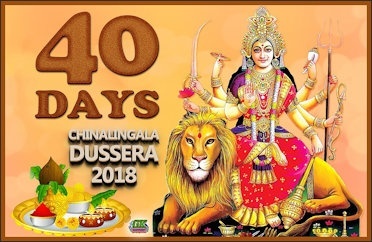
40 days to go to the beginning of Dusshera
Dussehra is held late in the month of Asvina (September-October) according to the Shaka calendar, India's official calendar. On the ninth day of Dusshera, people bless the "weapons" of their business life, including everything from plows to computers, with sandalwood paste. On the final day of Dussehra, in North India celebrating crowds set fire to huge paper effigies of Ravana.
In Delhi and other places in north India, plays are held that recall Rama’s victory over the demon Ravana and the rescue of his wife Sita. The event climaxes with 80-foot-high paper-and-wood effigies of Ravana being paraded through the streets and set on fire. Some of the effigies have fireworks that explode in their eyes. At Kullu, in Himachal Pradesh, people dress as local deities from neighboring villages converge for a huge celebration. Caparisoned elephant processions are held in Mysore. Dussehra is primarily a northern festivals and receives varying amounts of attention in other parts of the country. It is not that big in Tamil Nadu and southern India.
Durga Puja in Calcutta and West Bengal
Durga Puja in late September, Early October is the biggest event in Kolkata (Calcutta) and other cities in West Bengal. Held at the same time as Dussehra, it lasts for up to three weeks and honors the ten-armed, demon-chasing goddess Durga (Kali). Durga Puja is particularly important for Hindus in Bengal. After worshiping Durga for nine days, her image is taken to the streets in a procession and there is much celebration and dancing. To mark Durga leaving her mother after the nine day visit, her image is cast into water.
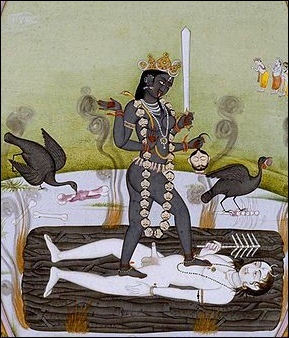
Kali standing above Shiva
Durga Puja is also known as the Kali Festival, Kali Puja, Shyama Puja or Mahanisha Puja. The festivities include merrymaking and family reunions, and displays of papier mâché statues of Durga, riding a lion and defeating demons.
Durga Puja is celebrated on the new moon day of the Hindu month Kartik especially in West Bengal, Bihar, Odisha, Assam and Bangladesh. It features terra cotta images of the goddess Kali, holding severed heads, and hundreds of pandals, fake buildings made of cotton stretched over bamboo. Some of the pandals are decked out in colored lights, and brightly painted with moving snakes, film stars and deities. Some cost hundreds of thousands of dollars to make. The festival features all night partying and fireworks.
In Calcutta, the festival climaxes with procession in which statues of the goddess are carried to the Hooley river and immersed in the water. People watch as statues break up into floating body parts. Afterward the praying continues in the Midan. In 1996, there were replicas of the Victoria Memorial airport that were over 30 meters long. The climax is when the pandals are dragged in the streets and destroyed by traffic and the images of Kali are dragged into the river.
Image Sources: Wikimedia Commons
Text Sources: “World Religions” edited by Geoffrey Parrinder (Facts on File Publications, New York); “Encyclopedia of the World’s Religions” edited by R.C. Zaehner (Barnes & Noble Books, 1959); “Encyclopedia of the World Cultures: Volume 3 South Asia “ edited by David Levinson (G.K. Hall & Company, New York, 1994); Wikipedia, National Geographic, the New York Times, Washington Post, Los Angeles Times, Smithsonian magazine, The New Yorker, Reuters, AP, AFP, Lonely Planet Guides, Compton’s Encyclopedia and various books and other publications.
Last updated March 2024
